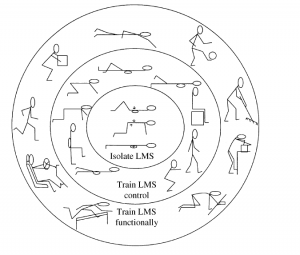Chronic Non-Specific Low Back Pain
Chronic Low Back Pain has intrigued me throughout PT school. The complexity typically involved in these cases has challenged me to think critically, holistically, and outside-the-box.While listening to the lecture on Treatment-Based Classification Systems during our first year, I knew I found my capstone project when Clayton discussed the expanding evidence for training local versus global abdominal musculature systems. Third-year coursework led to me focusing on research primarily based upon Richardson and Jull‘s Abdominal Drawing-In Maneuver and training appropriate motor control of the core musculature.
The ADIM is a method of training isolated activation of the Transverse Abdominis and Internal Obliques with co-contraction of the Lumbar Multidifus and pelvic floor. Since the 1995 publication of this pioneer article, evidence has grown to justify use of motor control training for chronic low back pain. Inability to activate the TA independently of the Rectus Abdominis and latency of activation of the TA prior to upper extremity movement differentiates low back pain subjects from healthy subjects. Motor control training of the deep abdominals re-establishes proper feed-forward activation of the TA and automaticity of the motor control pattern found in healthy subjects.
Training utilizes motor learning concepts by beginning in body-weight supported positions as the patient is in the cognitive stage of learning a new skill. Progression involves practicing the new skill (isolated activation of the TA) in more functional positions and incorporation into activities of daily life. Repetition of the contraction in functional tasks encourages automaticity of motor program to provide a more functional vertebral stabilization system.

I decided to target my capstone toward educating the first-year students in this simple, yet effective, intervention for a highly prevalent need. This educational module focuses on the theory of stabilizing the lumbar spine and evidence for, implementation of, and progression of the ADIM. Of course, no one exercise is the magic cure for our patients, so therapeutic exercise for all abdominal musculature was presented in an interactive fashion, with students contributing and demonstrating exercises.
Exercise Prescription Presentation for First Years
My presentation took place in early February. Overall, the evaluation of my presentation was positive. When comparing scores on a pre-test to a higher-level two month post-test, there was not a large variation between the scores. This was my first time utilizing a pre and post-test, and I believe I should have either kept the same type of question (ie pre-test had two anatomy questions and post-test had none) or at least the same level of difficulty. In examining answers to the post-test, it became apparent that I had not elaborated enough on when to progress patients to the next functional stage. In my second session with the first-years, which will take place this Thursday, I have incorporated a brief review of my presentation with more emphasis on progression.
When I was a first-year student about to go on clinical, I was wishing we had more opportunities to think critically through cases. To provide current first-years this opportunity, I created four mock patient scenarios for an interactive review session reminiscent of “case-based learning.” Utilizing third-year students as patients, groups of 7-8 will conduct a patient evaluation and develop a plan of care. Each student is required to contribute at least once to each component of the evaluation before the group is allowed to progress, thus encouraging equal participation. Once completed, groups will present evaluation findings and proposed interventions to their classmates as they would to a CI. The presentations mimic student practicals in calling for demonstration of 2 palpation techniques, 2 special tests, and 2 proposed interventions.
Case Scenario Prompts for Mock Patients
Case Prompts for First-Year Students
PowerPoint to Facilitate Case Presentations
Thank you for taking the time to look at my capstone project!
Also-a special thank you to Mike Gross, Jon Hacke, Mike McMorris, Mike Lewek, and Kimberly Jutovsky for advising me on this project, providing me with guidance and feedback along the way, and/or allowing me to use their class time for my presentations!



5 Responses to “Motor Control Training in Chronic Non-Specific Low Back Pain”
Mike Gross
I also like the way you “told the story” on the cpastone site. Mike
Mike Gross
Sam- Excellent job on your presentation, your cases, and the evidence table. You have really dug into this topic, and the presentation was unbelievably informative and entertaining. I really like the “cross-section” slide. Mike Gross
Michael Essa
This is an awesome project. I really enjoyed looking at your presentation slides. You have some great information on progression and the pictures that you included provide an excellent visual aid to accommodate visual learners. I think this is an excellent skill to have for the treatment of low back pain, but I also frequently use these techniques for a variety of other conditions. As we continue to “think globally” in an environment of regional interdependence, your project provides an excellent starting place for core/pelvic floor re education. Nice work!
Amanda Reed
Great job Sam!! After first year I remember feeling like I did not know much about interventions for back pain, so I love that you choose this topic. I also love the idea of having a follow up class with mock case examples to allow them to see the information being applied to a variety of cases. Great project!!!
Kathryn
Sam, GREAT project!! I was able to be a guinea pig for ADIM at my outpatient ortho rotation.. they had me demonstrate the proper way to do a posterior pelvic tilt and it was really hard! Education on proper co-activation and pelvic stabilization during abdominal strengthening is definitely an overlooked aspect of lumbar care.
On a different note, I love that you included mock prompts and case prompts!! What a great idea!
Good job!
KP